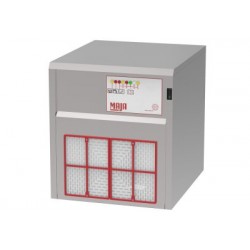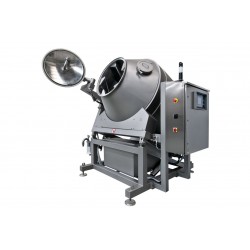Frozen food
Frozen food has become an essential part of our modern lifestyles, providing convenience, longer shelf life, and easy access to a variety of food products throughout the year. The process of freezing food on an industrial scale requires specialized equipment and proper storage techniques to maintain the quality and safety of the frozen products. In this article, we will explore the key steps involved in processing and storing frozen food products in an industrial setting, along with the necessary equipment needed for each stage.
Step 1: Freezing Process The freezing process is a crucial step in preserving the quality and freshness of food products. Industrial-scale freezing typically involves two methods: air freezing and cryogenic freezing.
Air Freezing: Air freezing is the most common method used in industrial settings. It involves circulating cold air around the food products to lower their temperature and freeze them. The key equipment used in air freezing includes blast freezers, tunnel freezers, and plate freezers.
- Blast Freezers: Blast freezers are designed to freeze food products quickly by blowing cold air directly onto the products. They are suitable for small to medium-sized products and are commonly used for freezing fruits, vegetables, and seafood.
- Tunnel Freezers: Tunnel freezers are conveyor-based systems that pass food products through a series of cold air chambers to freeze them. They are ideal for high-capacity processing and are commonly used for freezing meat, poultry, and prepared meals.
- Plate Freezers: Plate freezers use flat metal plates to freeze food products. The products are placed between the plates, and the plates are then chilled to freeze the products. Plate freezers are commonly used for freezing fish fillets, shrimp, and other seafood.
Cryogenic Freezing: Cryogenic freezing involves using extremely cold gases, such as liquid nitrogen or carbon dioxide, to freeze food products. Cryogenic freezing is faster than air freezing and helps to retain the quality and nutritional value of the products. The key equipment used in cryogenic freezing includes cryogenic freezers, spiral freezers, and immersion freezers.
- Cryogenic Freezers: Cryogenic freezers are specifically designed to use liquid nitrogen or carbon dioxide to freeze food products. The products are exposed to the extremely cold gases, which freeze them rapidly. Cryogenic freezers are commonly used for freezing fruits, vegetables, and bakery products.
- Spiral Freezers: Spiral freezers are conveyor-based systems that use a continuous spiral movement to freeze food products. The products are exposed to cryogenic gases as they move through the spiral conveyor, which freezes them quickly. Spiral freezers are commonly used for freezing meat, poultry, and frozen desserts.
- Immersion Freezers: Immersion freezers use a tank filled with cryogenic gases, where food products are immersed to freeze them. The products are submerged in the cryogenic gases, which freeze them rapidly. Immersion freezers are commonly used for freezing seafood, meatballs, and other small products.
Step 2: Packaging and Storage. Once the food products are frozen, they need to be packaged properly to protect them from freezer burn, dehydration, and contamination. Proper packaging is crucial for maintaining the quality and safety of frozen food products during storage. The key equipment used in packaging includes vacuum packaging machines, sealing machines, and labeling machines.
- Vacuum Packaging Machines: Vacuum packaging machines remove the air from the packaging before sealing it, which helps to preserve the quality and freshness of the frozen products. They are commonly used for packaging meat, poultry, and seafood.
- Sealing Machines: Sealing machines are used to seal the packages after the products are frozen and vacuum packed. They come in various forms, such as heat sealers or impulse sealers, and are used to create an airtight seal on the packaging to prevent air and moisture from entering and damaging the frozen products.
- Labeling Machines: Labeling machines are used to apply labels on the frozen food packages, indicating important information such as product name, batch number, expiration date, and storage instructions. Proper labeling is crucial for inventory management and food safety compliance.
Step 3. After packaging, the frozen food products need to be stored in suitable conditions to maintain their quality and safety. Industrial-scale frozen food storage typically involves large-scale cold storage facilities or warehouses equipped with specialized freezing and storage equipment.
- Cold Storage Facilities: Cold storage facilities are designed to maintain a constant freezing temperature for storing frozen food products. They are equipped with specialized refrigeration systems, insulation, and temperature monitoring systems to ensure that the products are stored at the optimal temperature for frozen food storage, typically between -18 to -25 degrees Celsius.
- Racking and Shelving Systems: Racking and shelving systems are used in cold storage facilities to store frozen food products in an organized and efficient manner. They come in various configurations, such as pallet racking, drive-in racking, or selective racking, and are designed to maximize storage space and provide easy access to the frozen products.
- Temperature Monitoring Systems: Temperature monitoring systems are crucial for ensuring that the frozen food products are stored at the correct temperature. They typically involve temperature sensors placed strategically throughout the cold storage facility, connected to a central monitoring system that alerts operators in case of any temperature fluctuations or deviations.
Processing and storing frozen food products on an industrial scale require specialized equipment and proper techniques to maintain the quality and safety of the frozen products. Air freezing and cryogenic freezing are the common methods used for freezing, while vacuum packaging machines, sealing machines, and labeling machines are essential for packaging. Cold storage facilities equipped with racking and shelving systems and temperature monitoring systems are crucial for proper storage. Following these best practices and using the right equipment can ensure that frozen food products maintain their quality, freshness, and safety throughout the processing and storage stages in an industrial-scale setting.
The list of the equipment for processing frozen food
1. Freezers: These are used to store frozen food at sub-zero temperatures to maintain their quality and safety. Chest freezers, upright freezers, walk-in freezers, and blast freezers are common types of freezers used in handling and processing frozen food.
2. Refrigerated trucks or vans: These are used for transporting frozen food from one location to another while maintaining the required temperature to prevent thawing or spoilage.
3. Thermometers: These are essential for monitoring and maintaining the temperature of freezers, cold rooms, and refrigerated trucks to ensure that frozen food remains at the desired temperature to prevent thawing or spoilage.
4. Packaging materials: These include vacuum-sealed bags, plastic wraps, aluminum foil, and freezer-safe containers for packaging frozen food, preventing freezer burn and maintaining freshness.
5. Cutting and portioning equipment: These include knives, slicers, and portioning machines for cutting and dividing frozen food products into desired portions for packaging or further processing.
6. Processing equipment: This may include blanchers, grinders, mixers, and other specialized equipment for processing frozen food, such as blanching vegetables, grinding meat, or mixing ingredients for frozen food products like frozen meals or pizzas.
7. Labeling and coding equipment: These are used for labeling and coding frozen food products with information such as product name, date of production, lot number, and expiration date to ensure proper inventory management and traceability.
8. Thawing equipment: Includes defrosters, equipment for thawing food before further processing or packaging.
9. Cleaning and sanitation equipment: This includes cleaning brushes, sanitizing solutions, pressure washers, and other equipment for cleaning and sanitizing freezers, processing equipment, and work surfaces to maintain a clean and safe food processing environment.
10. Monitoring and control systems: These may include temperature monitoring systems, alarms, and data loggers for continuous monitoring and control of temperature and other critical parameters to ensure the quality and safety of frozen food products.

 English
English
 Deutsch
Deutsch
 Français
Français
 Español
Español
 Italiano
Italiano
 Português PT
Português PT











